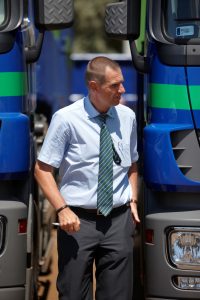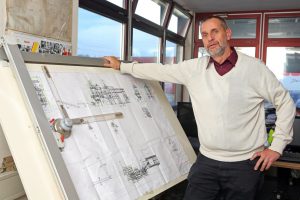 Hardly anyone knows the company Metall Recycling Mü-Gu as good as managing director Michael Grimm. In an interview, he gave us exciting insights into his daily business, reported about experiences gained and about his tonnage heavy challenges.
Hardly anyone knows the company Metall Recycling Mü-Gu as good as managing director Michael Grimm. In an interview, he gave us exciting insights into his daily business, reported about experiences gained and about his tonnage heavy challenges.
Mr. Grimm, you have been working for Müller-Guttenbrunn for many years. What makes your work in this company still so exciting after all these years?
GRIMM: I collected my first experiences in the company from 1980 to 1984 as trainee. Even in these days I remember to have realized that no day is like the other. And that has not changed during these 30 years, during which I have been working in this company, really nothing. We have continued to evolve, but we are still a classic family owned business, where one can always bring in his ideas as communication lines are short.
In this long period of time something must certainly have changed in the company?
GRIMM: Of course! I can well remember the times when I worked as trainee. In these days, we drove to landfill sites in the Waldviertel region from Monday to Friday to recover metals from these landfills in heavy work. Today this is completely unimaginable. When I started back in 1985, the companies were still happy to dispose of their metal bearing materials and even paid for it. Today, recycling has become a really tough business, in which people are already annoyed when a truck arrives something like one an hour earlier or later than planned.
Dadurch hat Dietmar Berger diesen Bereich als Geschäftsführer übernommen. Ich kümmere mich seither um den technischen Bereich – also die Betriebsleitung bei Metall-Recycling Mü-Gu.
A lot has changed for you personally as well. How did you develop from being trainee to become Managing Director of Metall Recycling Mü-Gu?
GRIMM: I started working on this site here in Amstetten after my studies at the HTL Waidhofen and my military service in April 1985, almost thirty two years ago. After many exciting projects as well as an intermezzo as operations manager of the newly founded Metran, it was in the ‘90’s that I moved into the planning of the logistics into the commercial area of the management team of the company. That is where I stayed until 2009, when I unfortunately fell out for a longer period of time for health reasons. After that Dietmar Berger took over this commercial role as Managing Director. Since then, I have been looking after the technical area, in other words as Managing Director for Operations for Metal Recycling Mü-Gu.
You have talked about exciting projects. I guess that the installation of the car-shredder in Amstetten more than 30 years ago must have been one of them in Amstetten – or am I wrong?
GRIMM: Indeed, that was really my first major project. For me, it was first all about understanding what a shredder is and how it works. Installing such a system is not a futility and especially in these days shredding plants were not available in abundancy. Furthermore, we have taken the choice to try out a new and for these days innovative type of construction.
That probably implied more challenges…
GRIMM: Absolutely. The new design originally did not keep up to its promises, i.e. it did not deliver what the design on the drawing board promised. Therefore, a lot of things went wrong in the first tests. Before the shredder went into final operation at all, quite some things had to be properly repaired first. On top of that, we already had purchased material on a large scale. As a result, 170 full waggons had to be worked off in other plants.
 That must have been an instructive experience to get started. In the meantime you can look back on a lot of experiences …….
That must have been an instructive experience to get started. In the meantime you can look back on a lot of experiences …….
GRIMM: There were and still are such challenges. This includes, for example, the development of own railway waggons or own special trucks. We also learned a lot from absolute emergency situations – for example, after the fire of the Neusiedler paper factory in 2000. Within one month some 14,000 tons of fire residues and 1,400 tons of scrap had to be treated. What made it particularly difficult is that there was quite some material still glowing and we did not have any experience with that. A similar situation developed after the flood of 2002: We had to scrap 3,500 brand new cars, all of which did not run a meter. That is where it took a lot of brain worm to organize and ensure the entire logistics for a smooth handling of the situations.
But doesn’t it require exactly that, anyway, with the huge quantities that are processed in Amstetten?
GRIMM: Sure, you have to realize that we are processing about 1.800 cubic meters of material every single day and this represents in other words 800 to 900 Metric Tons. As I already mentioned: no day is the same as the other and you are only as good as the whole team is. This is why we need a top-motivated team every single day.
 You have spent a lot of time outside on the production site, but surely you will also be spending many hours in the office. Where do you like it best?
You have spent a lot of time outside on the production site, but surely you will also be spending many hours in the office. Where do you like it best?
GRIMM: Definitely out in the yard. My office work is of course part of my role, but frankly my real habitat is indeed outside. Paper is patient, but scrap has to be processed! Out in the yard side, you quickly realize that scrap is not the same as scrap. Just look at the de-pollution station for end-of-life vehicles – I must say that I admire our employees, who always find all the problematic stuff and properly dispose of them. This is exactly what our team is working on at the production site every day.
You are getting excited now. But you also have quite a lot of decisions to be made in your office. What are you currently worried about?
GRIMM: The most important thing is to get continuity and stability in our production processes. However, we are largely dependent on our suppliers. Since the scrap prices vary enormously on a monthly basis, there are months with a lot of material and then again months with little material. This means that there are some months with a lot of work and then others with less. Additionally this waste material is always different – waste is not produced to specification. And finally, there is the routine maintenance schedule that is required to keep all systems going as well as large one-off maintenance projects.
 Is there currently such a large maintenance project?
Is there currently such a large maintenance project?
GRIMM: Yes, indeed, we are just in the process of exchanging some major mechanical parts of our large shredder. This exchange takes place in two phases of three to four weeks each. The first phase is already well behind us, successfully, and it took place at the turn of the year. And at the beginning of May, we have the big maintenance project finale and this is the installation of a 15-Metric Tons heavy filter that we have on our agenda. This is not going to be an easy task, but with our excellent team of experienced technicians, we will also master this.
For this huge maintenance project and for all the other challenges that are ahead of you this year – we wish you and your team all the best.





